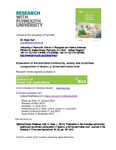Evaluation of the microbial community, acidity and proximate composition of akamu, a fermented maize food
| dc.contributor.author | Kuri, V | |
| dc.contributor.author | Obinna-Echem, PC | |
| dc.contributor.author | Beal, J | |
| dc.date.accessioned | 2018-12-04T21:41:50Z | |
| dc.date.available | 2018-12-04T21:41:50Z | |
| dc.date.issued | 2013-07-17 | |
| dc.identifier.issn | 0022-5142 | |
| dc.identifier.issn | 1097-0010 | |
| dc.identifier.uri | http://hdl.handle.net/10026.1/12981 | |
| dc.description.abstract |
Abstract BACKGROUND Akamu is a lactic acid-fermented cereal-based food that constitutes a major infant complementary food in most West African countries. The identities of LAB populations from DGGE analysis and conventionally isolated LAB and yeasts from traditionally fermented akamu were confirmed by PCR sequencing analysis. The relationships between pH, acidity and lactic acid levels and proximate composition of the akamu samples were investigated. RESULTS The LAB communities in the akamu samples comprised mainly Lactobacillus species, including Lb. fermentum, Lb. plantarum, Lb. delbrueckii ssp. bulgaricus and Lb. helveticus, as well as Lactococcus lactis ssp. cremoris. Identified yeasts were Candida tropicalis, Candida albicans, Clavispora lusitaniae and Saccharomyces paradoxus. Low pH (3.22–3.95) was accompanied by high lactic acid concentrations (43.10–84.29 mmol kg−1). Protein (31.88–74.32 g kg−1) and lipid (17.74–36.83 g kg−1) contents were negatively correlated with carbohydrate content (897.48–926.20 g kg−1, of which ≤1 g kg−1 was sugars). Ash was either not detected or present only in trace amounts (≤4 g kg−1). Energy levels ranged from 17.29 to 18.37 kJ g−1. CONCLUSION The akamu samples were predominantly starchy foods and had pH < 4.0 owing to the activities of fermentative LAB. © 2013 Society of Chemical Industry | |
| dc.format.extent | 331-340 | |
| dc.format.medium | Print-Electronic | |
| dc.language | en | |
| dc.language.iso | en | |
| dc.publisher | Wiley | |
| dc.rights | Attribution-NonCommercial-NoDerivatives 4.0 International | |
| dc.rights.uri | http://creativecommons.org/licenses/by-nc-nd/4.0/ | |
| dc.subject | akamu | |
| dc.subject | lactic acid bacteria | |
| dc.subject | yeasts | |
| dc.subject | acidity | |
| dc.subject | proximate composition | |
| dc.title | Evaluation of the microbial community, acidity and proximate composition of akamu, a fermented maize food | |
| dc.type | journal-article | |
| dc.type | Article | |
| plymouth.author-url | https://www.ncbi.nlm.nih.gov/pubmed/23765582 | |
| plymouth.issue | 2 | |
| plymouth.volume | 94 | |
| plymouth.publisher-url | http://onlinelibrary.wiley.com/ | |
| plymouth.publication-status | Published | |
| plymouth.journal | Journal of the Science of Food and Agriculture | |
| dc.identifier.doi | 10.1002/jsfa.6264 | |
| plymouth.organisational-group | /Plymouth | |
| plymouth.organisational-group | /Plymouth/Faculty of Science and Engineering | |
| plymouth.organisational-group | /Plymouth/Faculty of Science and Engineering/School of Biological and Marine Sciences | |
| plymouth.organisational-group | /Plymouth/REF 2021 Researchers by UoA | |
| plymouth.organisational-group | /Plymouth/REF 2021 Researchers by UoA/UoA06 Agriculture, Veterinary and Food Science | |
| plymouth.organisational-group | /Plymouth/Users by role | |
| plymouth.organisational-group | /Plymouth/Users by role/Academics | |
| dc.publisher.place | England | |
| dcterms.dateAccepted | 2013-06-14 | |
| dc.identifier.eissn | 1097-0010 | |
| dc.rights.embargoperiod | Not known | |
| rioxxterms.versionofrecord | 10.1002/jsfa.6264 | |
| rioxxterms.licenseref.uri | http://creativecommons.org/licenses/by-nc-nd/4.0/ | |
| rioxxterms.type | Journal Article/Review |



